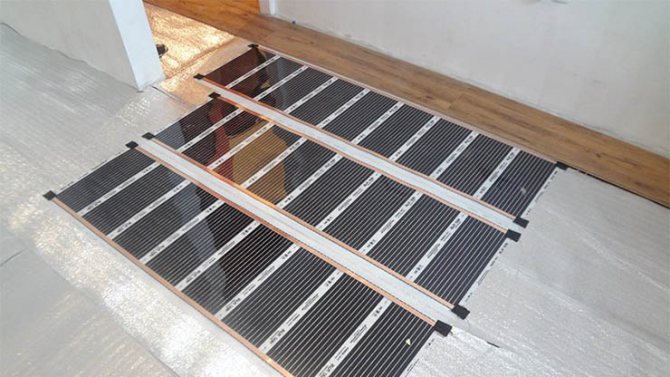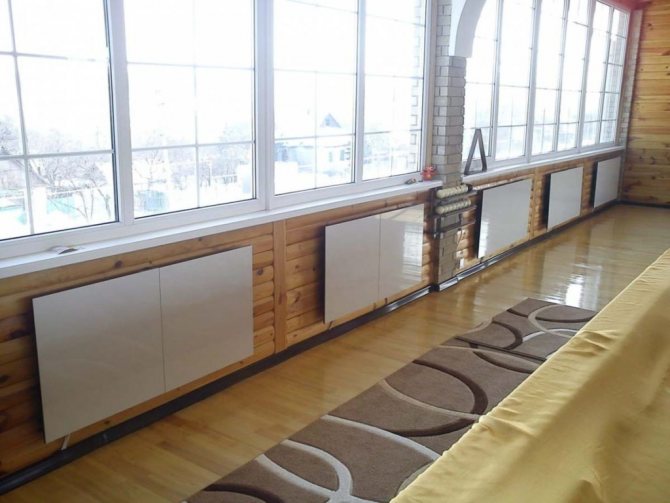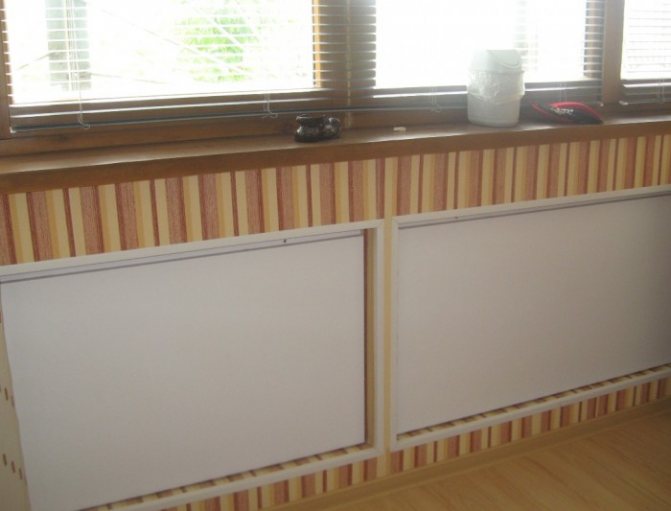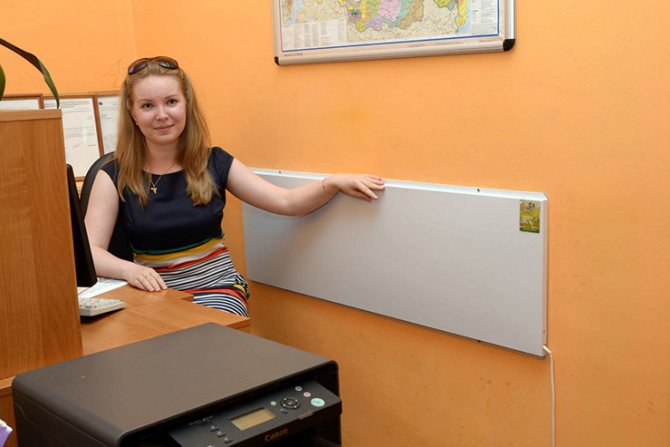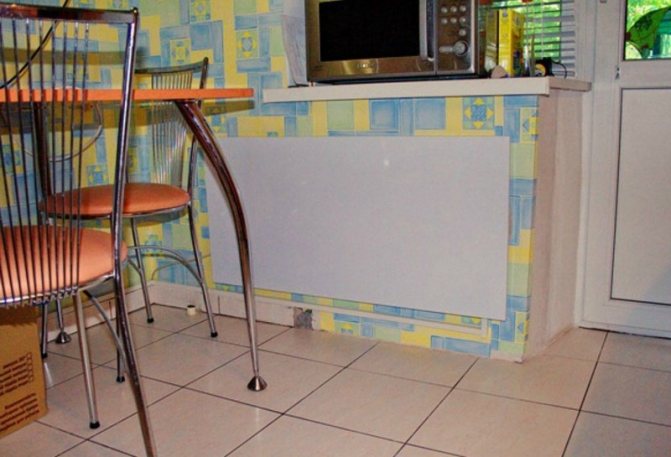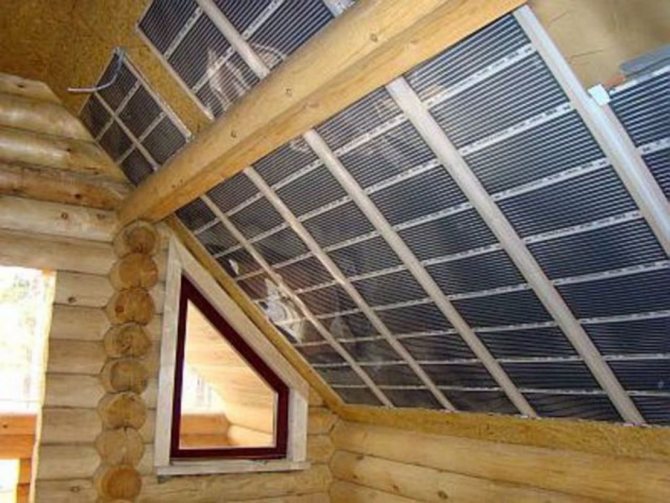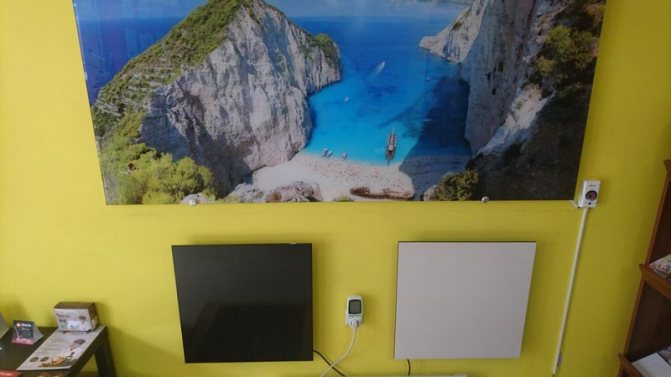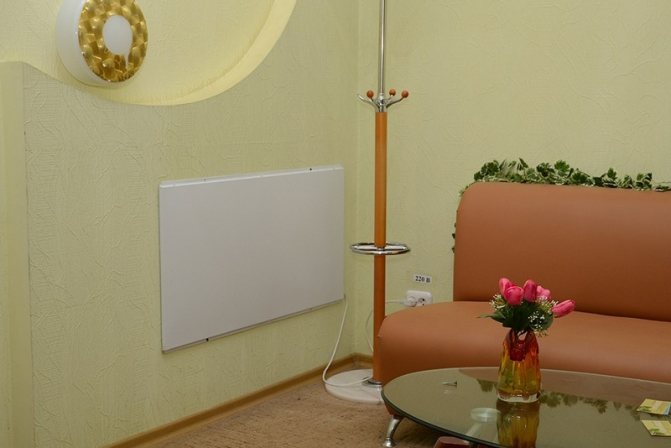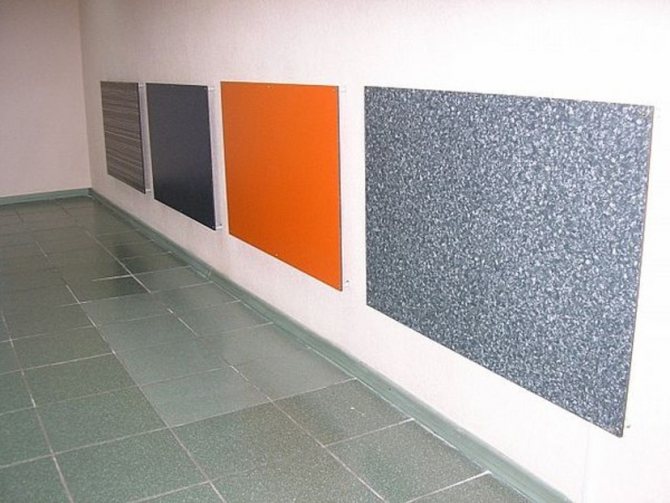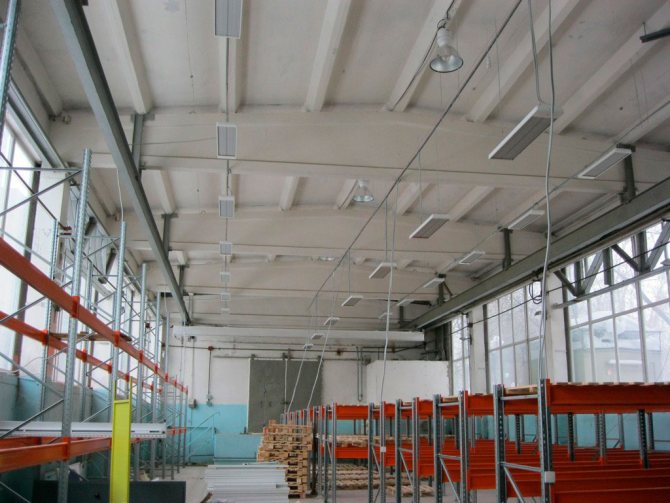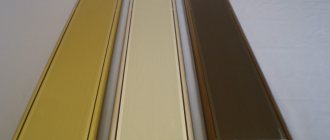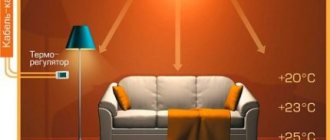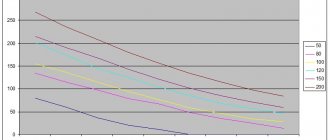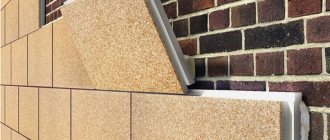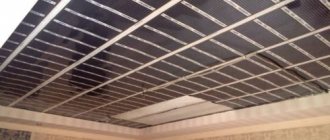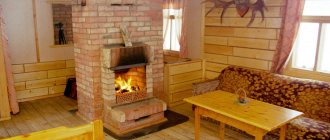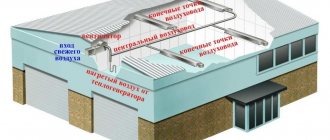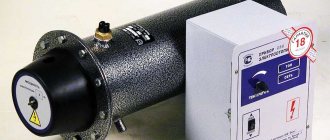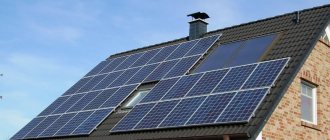What is infrared heating
Infrared (IR) heating works differently than conventional convection heating. The radiated waves heat up objects - walls, floor, ceiling, furniture - and already from them heats up the air in the room. A person who is in a room heated by infrared radiation is enveloped in heat from all sides, and from the floor as well. For this reason, the level of comfortable temperature is reduced by a couple of degrees, which means that under the same conditions, heating costs will be lower.
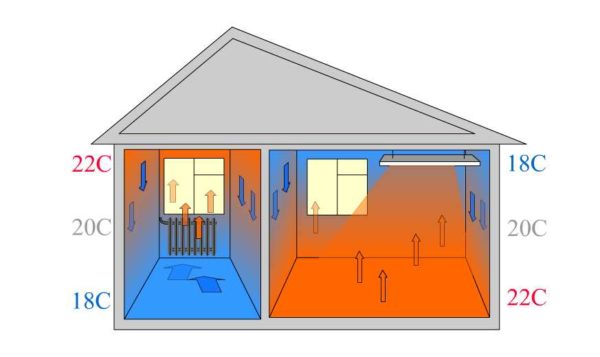
Difference between traditional heating and infrared
Nevertheless, miracles do not happen and only heating the house in which heat loss is minimized will be economical. Under such conditions, of course, all heating costs will be less, including for any electric one. But with IR heating, the temperature really needs a lower one. The second reason for saving is the presence of a thermostat. If equipped, the heaters operate for a short period of time when the room temperature drops below the set one. Otherwise, the heaters are in operation all the time, the room is hot, you have to open the windows, and the electricity bills are large (to put it mildly).
Infrared heating can be used as the main one, or it can be used as an additional one to create more comfortable conditions in a specific place - near the desktop, in the recreation area, etc.
What are infrared heating panels?
All products of this type are divided into two large groups:
- Hinged... Most often they are equipped with a colored metal case heated by means of an infrared emitter. The device is powered by an ordinary socket Both a separate and a mounted type of installation are used.
- Built-in... The basis of such a panel is a plasterboard board covered with a layer of insulation. The infrared emitter located on top is made in the form of a carbon conductive wire protected by a polymer sheath. The panel is powered by a standard 220 V.
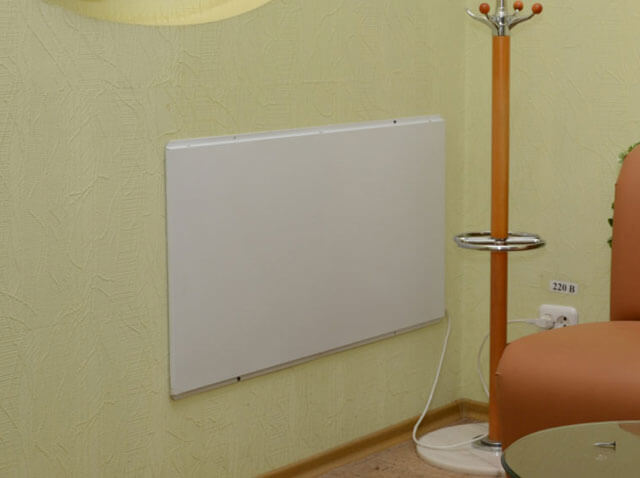

As for designer wall heating panels, they can be of different colors and sizes, and usually stand out in a separate line. A slab in the form of a plinth looks very original: it can be used to arrange the perimeter of a heated room. When decorating walls with plasterboard, wall heating can act as the main one. In those dwellings where a source of primary heating is already available (solid or liquid fuel boiler), heating panels play a secondary role.
It should also be said about the weaknesses of these devices:
- Although the sensation of warmth from the rays comes almost instantly, infrared devices operate mainly locally: one part of the room will be heated, and the other will not.
- Due to the uneven effect of heat on the human body, he may experience health problems - headaches, fatigue, chills.
- Since the operation of the IR panel does not heat up the air, but the surrounding objects, a plastic smell may appear in the room due to the heating of the plastic surfaces.
- Despite the high power of such heaters (about 1.2 kW), their range of action is usually limited to a space of 8 m2.
- Infrared radiation has a negative effect on the eyes.
Principle of operation
The principle of operation of solar cells is to generate electrical energy, they do not accumulate or form it in any way. When the rays of the sun directly hit their surface, they are immediately converted into current and removed from the panel.
Each plate can generate 250 W, therefore, to improve the principle of operation, they are trying to be installed closer to each other. The current obtained as a result of photosynthesis, through the distributor enters the batteries, and then into the inverter of the power grid of the house.
It should be noted that the volume of solar batteries affects the duration of the daily operation of the batteries. The batteries are recharged during the day, while the energy generated in the last day is being used.
The principle of operation is simple, and at the same time effective due to the "semiconductor". A semiconductor contains atoms that can, thanks to an external electron, capture or reflect other electrons. As a result, the surface of solar cells is covered with this material. This "semiconductor" is Selenium and Silicon.
What other types of infrared heating are there?
Ceiling infrared panels do not take up much space. They can be used in rooms over three meters high. They are distinguished by their quiet operation, environmental safety and the ability to organize heating of a certain area. Space heating panels are easy to install and operate. Some manufacturers of cassette ceilings complete their products with special heaters.
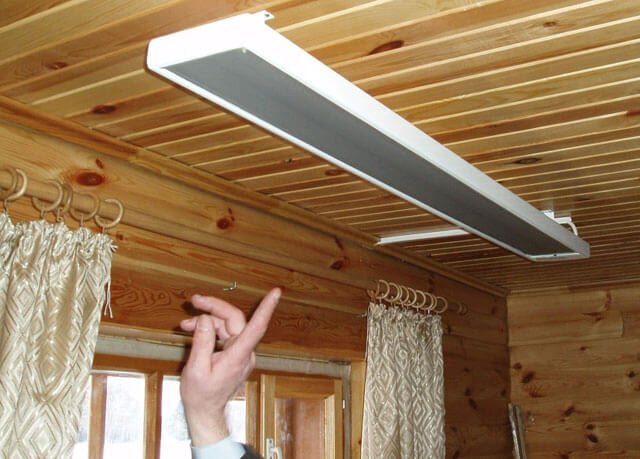

In addition to the significant consumption of electrical energy, ceiling heating panels have another drawback: they are not always able to maintain the overall aesthetics of the room. When it comes to wall mounted infrared heating panels, they are a good replacement for traditional batteries. Due to its small thickness and light weight, the installation of such heating can be carried out independently.
Advantages and Disadvantages of Solar Heating System
There are not many advantages of a solar heating system, but each of them becomes a reason for constant experiments:
- environmental Safety. It is an environmentally friendly source that is safe for residents and the environment and does not require the use of standard fuels;
- autonomous work. The owners of such systems do not depend on the cost of energy resources and on the economic situation in the country;
- economical consumption. While maintaining the standard heating system, you can reduce the cost of paying for hot water supply;
- availability. To install solar panels for home heating, you do not need to travel around the authorities and ask permission.
Users also highlight the cons:
- the high cost of juice equipment, which is necessary for putting the system into operation;
- direct dependence of the amount of heat received on the geographic location and weather;
- the presence of an additional source (solar system or gas boiler).
To get a great return, you need to constantly monitor the health of the collectors, clean them or debris and protect them from the appearance of ice at low temperatures.
If the temperature is often below 0 degrees, then it is important to take care of additional thermal insulation not only for the solar system parts, but also at home.
Features of infrared heating systems
An infrared device for heating any type of room is considered the best and most functional. Heating with infrared lamps has many advantages over many other heating devices. Before purchasing and installing such heating devices, you need to carefully carry out all the required calculations.
Expenses consist of items such as:
- Cost of equipment;
- Installation costs;
- Operating costs.
When carrying out calculations, it is imperative to take into account the area of the room where installation work needs to be carried out. Experts recommend not covering the entire area, but only partially mounting the film coating.
Before choosing and installing an infrared heater, you need to carefully read the technical characteristics of the system, as well as the features of this heating method for a certain type of room. If you correctly carry out all the calculations and carry out the installation, then the infrared heating system can be very profitable and rational.
Infrared heating panels
IR panels are increasingly used
All people are familiar with infrared radiation. Indeed, it is it that occupies most of the spectral radiation of the Sun. Infrared rays are invisible to the eye and occupy the region between the red end of the spectrum and microwave radio emission. A person can feel the IR rays as warmth. IR waves are emitted by each object and the more it is heated, the shorter the waves.
The first infrared heaters appeared in Switzerland in the 60s of the last century, and thus the history of infrared heating goes back more than half a century. The principle of operation of a heating system with infrared emitters is very similar to the "work" of our luminary. The only difference is that infrared emitters do not work from a thermonuclear reaction, but from an energy source. In addition, unlike the sun, infrared heating devices may have no visible radiation or have a faint glow. This does not affect the quality of heating, since the heat transferred to surfaces is the result of invisible radiation.
Reviews of numerous users about heating with infrared heaters are generally positive. Perhaps the only significant drawback is the cost of electricity. However, in the long term, and also as an alternative heat source. such equipment is out of competition. Prospects for the installation of infrared heaters for home heating are deservedly appreciated abroad. Quite often, outdoor cafes, verandas and terraces, all kinds of open areas in parks or on the decks of ships are heated with gas or electric infrared heaters. In our country, infrared heating equipment is not so popular, but gradually, with the development of technology, it becomes more and more common. Consider a variety of emitters such as infrared panels.
Film heating
In a private house, the heating battery may not be entirely functional, which is why many people prefer infrared heaters, with which it is much warmer, regardless of the fact that there is a severe frost outside the window. Heating with such heaters is comparable to ultraviolet rays. However, it is worth remembering that film heating is best used not as the main, but as additional heating of the house, since its performance depends entirely on the uninterrupted supply of electricity.
Film infrared emitters are considered a very good device, however, for high-quality heating, certain calculations need to be made, namely:
- The total area of the house and each room where the film will be mounted;
- The number of window openings and their sizes;
- Method of thermal insulation of the foundation and walls;
- Electric power.
For heating a house that is well insulated from the inside and outside, 50 W / h is enough for each meter of heated area. If you need to heat a panel house, then in this case a much higher power will be required, for example, 180 W / h. However, it should be noted that after thorough warming up, the automatic system will switch to the constant temperature mode. Ultraviolet heating of a house with film panels is energy-efficient, as it consumes much less electricity than floor-standing infrared heaters.
Pros and cons of heating with infrared heaters
Like all inventions in the world, IR equipment has its advantages and disadvantages.The choice depends on the ratio between them and what quality of equipment is a priority for the consumer at the moment. We list the main features of heating with infrared heaters, perhaps this will help you make your choice:
- IR devices do not directly affect the air, which means they do not dry it and do not change the microclimate in the room;
- for the same reason, convection flows and drafts are not created, dust particles are not transferred;
- air heats up from all surfaces affected by the device, and does not accumulate under the ceiling as with conventional heating;
- the system is completely fireproof, all devices have overload sensors and will turn off the system in case of an emergency;
- the compact size of infrared radiation devices allows them to be installed even in small rooms, and often completely hidden under the decorative coatings of walls, floors or ceilings;
- the equipment is easy to install and connect even without special skills;
- all equipment has a sufficiently long service life, since there are no parts in it that would fail as a result of wear and tear. And in the event of a breakdown, it is possible to replace an individual element or module;
- The IR heating system can be fully automated, and each device is programmed for its own operating mode;
- there is a possibility of local heating in a room of any size;
- complete environmental friendliness: no noise, dust and emissions of combustion products;
- the cost of devices can be very different and depends on the specific model;
- operating costs depend on the choice of the equipment operating mode;
- you can use infrared equipment in any room, provided that the devices are located correctly.
The brightest expectations can be clouded by electricity bills. Therefore, before buying and installing infrared panels and heating heaters, read reviews, make calculations. This will help you find the most optimal solution.
Interesting on the topic:
Ceiling heating: infrared and pendant
Pros:
- in those rooms where the ceiling height reaches three or more meters, they are very economical;
- you can warm up just any specific part of the room;
- noiseless, waste-free, environmentally friendly.
- easy to install and operate.
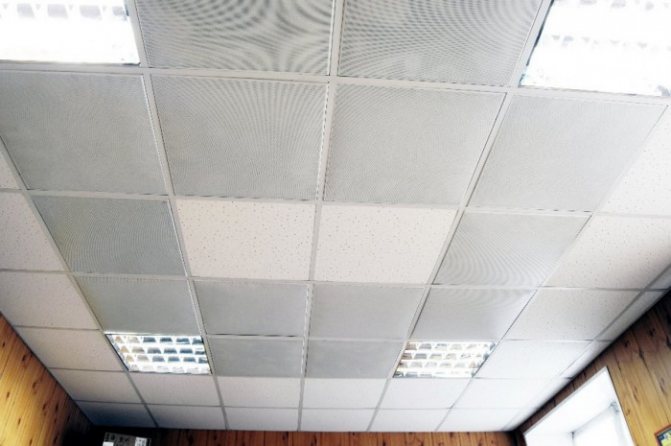

Infrared panels on the ceiling
Some brands produce cassette heaters that can also be installed in suspended ceilings.
Disadvantages:
- it is not always possible to combine the design and style of a room with a suspended ceiling heater;
- electricity consumption is the main disadvantage of these systems.
The device and varieties of infrared panels
Wall mounted infrared heating panels
A heating element, or rather a heat emitter in each infrared heating source, is a special lamp. In principle, the well-known incandescent lamp is also a source of infrared radiation. After all, less than 10% of the energy is converted into light, and the rest (90%) is precisely infrared radiation. Different types of lamps can be used in modern infrared heating panels. The most common source of energy is electricity, but it can also be gas. The reflective surface is another essential component of an infrared radiator. It is a mirror-polished steel plate, curved so as to focus the radiation of the lamp in a certain place. The radius of the radiator and the coverage area are the main characteristics when choosing equipment for heating.
The design of modern infrared heaters can vary. Most often these are minimalist wall panels of strict geometric shape and small thickness or ceiling equipment.It should also be noted that the properties of the device depend on the shape of the reflecting element: the more volumetric and convex the reflector, the greater the focusing and coverage area.
IR heating as an alternative to traditional heating
Compared to infrared heating, convector heating. gas or solid fuel, occupy, perhaps, a more leading position in Russia. But this is only in terms of prevalence. This can be explained by both habit and insufficient information about this high-tech heating method. If we compare efficiency, then infrared heating is the undoubted leader among other methods of heating a home. Moreover, infrared equipment surpasses traditional heating devices (stoves, heating boilers, electric convectors, etc.) in several parameters at once:
- ease of installation;
- lack of noise;
- lack of combustion products;
- ecological cleanliness and many others.
Types of IR panels
Ceiling infrared panels
Infrared heating can look like traditional radiators. And an ignorant person will not notice the difference, especially if there is no visible radiation. However, the very principle of heating is completely different. Infrared rays penetrate the air and directly heat objects: furniture, floors, walls, people. That is, the radiation source is all surfaces that are in the range of the IR emitter. Infrared heating radiators are usually placed on the walls. Moreover, if you hide them behind decorative panels, this will not be an obstacle to radiation. Skirting systems are another type of infrared heating batteries. As the name implies, they are usually installed around the perimeter of a room or some designated area at the junction of walls and floor.
Ceiling panels can be either external or hidden. The external ones are emitters of various sizes and shapes, the internal ones are modules that can be built into false ceiling systems instead of plasterboard or plastic boards.
In terms of power and area of influence, infrared equipment also varies significantly. It is used not only for heating housing, but also for heating office, retail and industrial premises, as well as all kinds of warehouses, hangars, boxes, etc. Moreover, in rooms with high ceilings - this is perhaps the most effective way to bring heat from the source to the consumer without loss. The reviews of those who have already installed infrared heating panels are the most favorable. They usually emphasize not only their versatility and environmental friendliness, but also the complete automation of the system and the possibility of significant savings in comparison with other types of heating.
Installation recommendations
To install infrared heating panels, you do not need special knowledge and experience. The tools that will be needed during installation are at the disposal of every owner. The documents for the device should contain step-by-step installation instructions. If you have not found it, go to the website of the panel manufacturer, there is definitely such information.
Panel mounts are already included with them. If you have your own vision on this matter, you can choose the fasteners yourself. However, be sure to make sure it can support the weight of the panel you choose to install.
Here are a few more nuances, which it is better to find out about in advance, that is, before starting the installation:
- A large percentage of the manufactured panels are ceiling panels. Many have corner brackets, but not all. Therefore, pay attention to this point when buying. Swivel models are better because their work surface can swivel up to 30 °.
- For rooms with high ceilings, models are produced that are suspended on chains. This allows you to control the radiation intensity and select the area to be heated.
- To calculate how much power the heating system should be in order to heat the room with IR panels, proceed from the calculation - 1 kW per 10 m2.
- Mount the panels within the recommended mounting height, as most lower power panels heat the room more efficiently and more evenly by eliminating blind spots and hot spots.
During installation, do not allow the heating surface to come into contact with combustible and flammable substances.
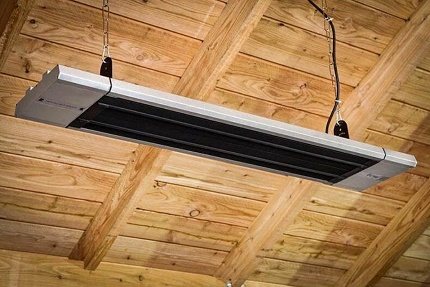

Ceiling infrared appliances are supplied with a complete mounting kit. Supplied with brackets, hooks and chains depending on the model
Take care of high-quality insulation of the wiring contacts when installing the device. Use plastic caps or electrical tape for this.
Types of infrared heating panels
According to the heating method, a distinction is made between conventional and convection devices, which heat and distribute air around the room between the wall and the metal case. They are distinguished by faster heating, due to which a comfortable temperature for a person is achieved in a matter of minutes.
There are also devices with a thermostat that allows you to set the required temperature in the room. But this is not its only advantage. Thanks to the thermostat, you can maintain the set temperature, while the electrical appliance will turn on only when the temperature drops. This gives a real economy of energy resources, since the panel does not work constantly, but turns on when necessary.
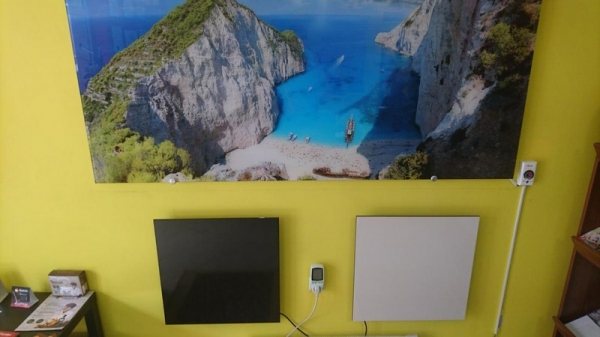

Infrared heating panels photo
If we talk about the design of the panels, then in addition to elegant white heaters in a minimalist style, manufacturers produce color models with several dozen shades. But that's not all. It is possible to order a panel-picture with an exclusive design pattern, which will not only warm up on a cold autumn evening, but also become a bright accent in the room. Depending on the power of the device and the area of the room, 1-2 infrared heating panels are required per room.
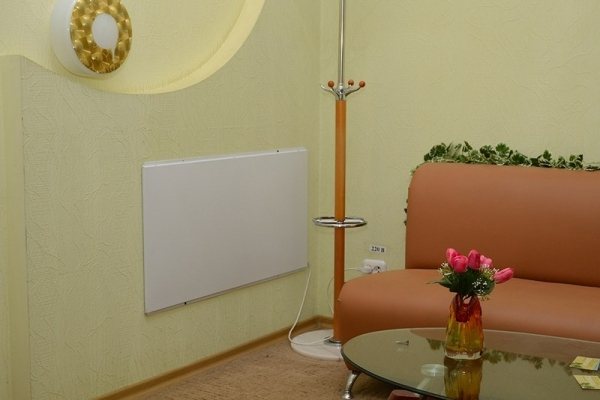

Infrared heating panels photo
A few words about the types of infrared heaters
Conventionally, this type of climatic technology is divided into three groups depending on the location: floor, wall and ceiling. The difference between all of them lies only in the installation scheme and the presence or absence of some functions.
Floor
Devices of this type of installation can be carried, which makes transportation an attractive advantage when choosing a purchase. Either a handle or a special compartment for installing the cord is responsible for the convenience of transfer, and there may also be small wheels.
As a rule, such heaters have special sensors. For example, one of them saves from overheating, the other turns off the device when it is overturned. Interestingly, they add thermostats or the ability to control from the remote control.
Wall
This type of infrared heater has two places - a niche under the window or the lower part of the wall.
As a rule, they are made similar to central heating radiators, as many already have in a house or apartment, only they are flat. Immediately, we note that they heat no worse than other types of IR heaters.
All wall-mounted options boast a thermostat and a system that protects the device from overheating. Since the wall model is heavier than the floor or suspended model, it is mounted for a long time, taking into account all the nuances of the room design. During installation, you may need to decorate the device with various decorative elements, such as ornament, stone, stucco, or simply paint it in the desired color.
Ceiling
Usually, ceiling options are made very similar to lamps, and they are rather bulky in size, and rather heavy in weight. Such heaters are not entirely suitable for installation in a residential area - it is better to use them in non-residential areas such as an office, garage, various warehouses.
The advantages of this version of the IR heater are their high power, which will allow you to generate a lot of heat, the presence of a thermostat, as well as a large area coverage, which can help in heating rooms with a large square. You can control such a heater using the remote control, which is quite convenient.
Important! Separately, it is worth noting the mixed models with wall and ceiling mounting or floor and wall mounting. Their versatility allows you to expand the possibilities of heating the room by choosing the installation location. You can read about the safety of infrared panels - more details here.
Which is better wall or ceiling panels
On sale you can find various types and sizes of such products, and on thematic forums about infrared heating panels, reviews often come across contradictory. Some buyers note the efficiency and simplicity of the device, while others say that they provide little heat. What is the best choice?
Ceiling infrared heating panels are designed for rooms with a height of at least 2.5-3 m - in any case, it is desirable that at least 50 centimeters remain between them and the head of a person of average height. In a very small room, they may not be very comfortable, but they are a good option for large rooms in which only zone heating is required.
Ceiling panels emit heat, which does not heat the air, but is transferred to objects, and the heat will be felt differently. It will be hotter at the top of the room and colder at the bottom.
Wall panels are a good addition to a large room that lacks warmth from conventional heaters. They can be placed in several areas of the room for constant uniform heating, or they can be hung in only one area where the most heat is needed.
For example, if you need additional heating in your bedroom, you can place such a panel near the bed. This will allow you to enjoy the warmth and comfort during a cozy evening, while the cost of additional heating will be small.
In any case, both the one and the other option will be more effective than the usual convective heating. If you put ordinary batteries in the room, the air will constantly circulate around the room: it warms up from the radiator, rises, cools down, falls.
Because of this, the heated air is always at the top, and the floor will be cold. Installing infrared panels will allow you to forget about this drawback, since the surfaces themselves warm up first of all, and then they give off heat to the home atmosphere.
Which is better: floor or ceiling?
Where is it better to place: on the ceiling or on the floor, or maybe on the walls? It is worth considering that warm air rises upward, so wall heating panels are less efficient.
With ceiling radiators, as well as those built into the floor, the floor will heat up, and the warm air will rise up to the ceiling. Therefore, the choice of installation on the ceiling or floor is not particularly important, choose according to your taste. Now more modern installation options have appeared: skirting-heaters and wall-mounted eint panels-pictures. It is worth considering that it is the objects that heat up, and not the air, therefore, the feeling of comfort is felt precisely in the proximity and direct effect of the heater.
otoplenie-doma.org
Benefits of heating with infrared panels
Modern heating methods are based on more advanced technologies, therefore, they have more advantages in comparison with traditional devices. What are the positive aspects of infrared ceramic heaters?
Rapid heating of the room - 10-15 minutes is enough to warm up the room. Versatility. They can work as the main source of heat, and be used for local heating of individual zones (for example, you can only heat your workplace or a sleeping area with a bed). For the organization of autonomous heating of a house or apartment with IR panels, permits are not required. Fast installation. It only takes one day to install the panels in a standard two-room apartment. Alternative. If you do not want to punch holes in the walls, then install panels on legs.
Infrared heating panels photo
Simple controls. Specify the temperature that is comfortable for you, and the device will take care of itself to constantly maintain it in the room. Individual settings. There is an opportunity in each room to adjust its optimum temperature. Thermostat. It will not only save finances, but also prevent air overheating. Does not dry the air. Suitable for installation in rooms where children live, as well as people with allergies and asthma. The infrared panel heater does not dry the air and does not burn oxygen and dust particles that provoke the appearance of toxic gases. Moreover, infrared radiation is even used in the treatment of asthma.
Heating with infrared panels photo
Safety. The outside of the panel does not heat up and cannot cause burns when touched. The heating element is located inside the appliance, so it cannot cause discomfort if you accidentally touch the panel. Parents of small children can also be calm, who, having played out, will touch the "battery" more than once. Heating with infrared panels can be organized not only in the living room and bedroom, but also in the children's room. Profitability. According to the assurances of the manufacturers, the heating panels of the new generation consume 30-50% less electricity than the classic ones, with the same heat output. Also, no additional devices (boiler), a separate room (boiler room) and a communication system (ventilation) are required. Long service life. The average life of the IR panel is 30 years, some manufacturers give a 50-year warranty. Fire safety. The appliance does not contain components that can catch fire or that can lead to a fire. Unusual design. You can choose a panel painting with a thematic image that matches the room - children for the nursery, exotic flowers for the living room, relaxing and pacifying pictures for the bedroom.
Infrared panel heater photo
If you strive to decorate your home in an unusual and original way, then infrared heating panels will help you with this. And low operating costs along with high efficiency and a long period of operation allow us to speak of them as one of the best heating devices.
IR panels design
The main components of IR panels are lamps and reflective elements. Lamps function as an emitter of infrared rays. Foil material acts as a reflector.
Basically, the models consist of the following four components:
- glass-ceramic part with built-in heating element;
- two plates of metal material;
- an additional unit with a built-in heating element is located between two metal sheets;
- metal base with fixing fasteners that are attached directly to the wall.
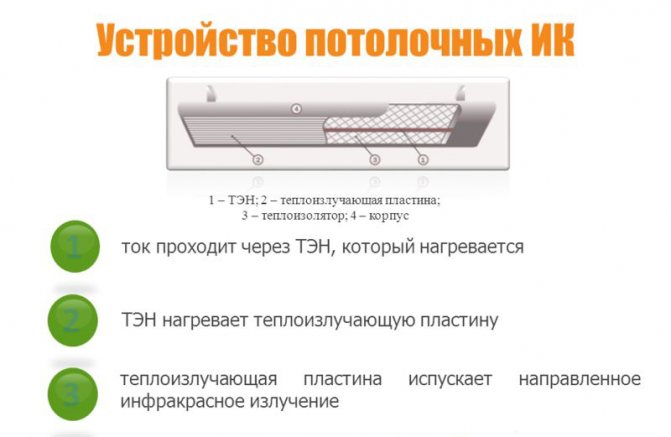

The scheme of operation of the ceiling infrared heater
With the help of a heating element located between the two sheets, heating occurs, and the heater located on the front of the device emits infrared rays. Thus, you can get two types of heating - convection and infrared. This type of thermal equipment is called active.
But not all devices have this configuration. There are simplified views in which only IR emitters are present. Such units are much cheaper at a price, but the quality of their work is certainly an order of magnitude worse. If we consider the industrial version of heating systems, then they are produced only with infrared emitters. They are mounted on ceilings, fastened to floor slabs. By their configuration, they are ceiling-mounted.
Selection of panels and their installation in the apartment
The power of the panels for the house is selected at the rate of 1 kW for 20-25 cubic meters of space. Knowing the size of the room, it will be easy to calculate which panels are required for it.
If heating radiators are already installed, and panels will play a secondary role, it is necessary to reduce the power and choose the most compact equipment. The efficiency of such heaters reaches 90%: this means that they use electricity as efficiently as possible, so their installation will be much more efficient than installing conventional radiators or convectors.
To heat the coolant in the system, not only electricity can be used. Gas heating will be much cheaper, and if there is such an opportunity, you can think over connection options. The coolant will be warmed up in the exchanger, and then piped into the panels, which will distribute soft heat throughout the room. However, this is a rather difficult option: it is much easier to equip a conventional system with heating elements.
Externally, the wall panel is a thin plate, it can be of various sizes. You can buy regular products, or you can order designer panels, whose outer surface will be decorated with bright multicolored patterns.
Such items can be placed anywhere in the room and will look good in the interior. Having chosen the place for installing the panels, you can proceed directly to the installation:
A kit is purchased, which, in addition to the panel itself, includes a cable, a thermostat and a sensor system that will allow you to monitor the temperature in the room. With their help, it will be possible to maintain a stable heating level, which will be regulated without human intervention. In this case, you can pick up several panels that differ in power: thanks to the operation of the thermostat, they will be able to maintain the optimal temperature regime. You need to determine the place for the panels. The best option is the walls between the windows: this will direct the warm flow into the room, and the radiation will provide uniform heating. You can hang them on the walls like paintings, or install them on the ceiling in accordance with the design project. A set of sensors and a thermostat are installed in the room, the system is connected with a cable into a single whole and connected to the network. The cable can be stowed away in a box and fixed to the wall to keep the room tidy.
Usually, installation takes a minimum of time; even a home craftsman who has not previously worked with such systems can easily install such panels. Manufacturers supply products with detailed instructions describing how the system works. You can calculate at what point in the room it is constantly coldest, and it is there that it will be appropriate to place the thermal infrared panel.
If self-installation is difficult, it is better not to risk it, but to seek the help of a specialist. In addition, it is advisable to protect the power grid from sudden voltage surges using stabilizers. Infrared panels negatively tolerate sharp increases and decreases in the electrical system, so they can fail for a long time even with a single failure.
An important advantage of such panels is their versatility.Equipment of the required capacity can be selected not only for the living room, but also for the production workshop, assembly hall, any other large room in which uniform heating can be ensured from all sides
Thanks to the high energy efficiency, it will be possible to minimize heating costs and at the same time create the most comfortable environment in the room.
JavaScript required or player update required!
Varieties of devices
A wide variety of IR panels are available today. Based on your needs, you can easily find the right equipment.
According to such a parameter as the installation method, it is divided into two main types:
- Hinged. These devices are distinguished by a colored metal body. It heats up thanks to the emitter installed in the structure. After installation on the wall with the help of fasteners, the infrared panel is ready for use, you just need to plug it into the socket.
- Built-in. Thermal infrared panels of this type are based on drywall, on which two layers of the emitter are placed, as well as insulation. An infrared emitter is installed in the upper part - a carbon conductive thread. On top of it is a protective polymer coating. The devices are connected to a 220 V network.
There are also design panels for placement on the wall, they can be of different sizes and colors. Skirting panels are also available in stores. Placed around the perimeter of the room, they replace the usual skirting board.
If you finish the walls with drywall, then wall-mounted infrared heating can be used as the main source of thermal energy. If there are familiar cast-iron radiators in the apartment, such a device will be a good option for backup heating.
Sales quality and prospects for the development of solar technologies
The modern market and its sales technologies do not leave the buyer an unambiguous assessment. Especially high-tech equipment and devices. This also applies to the market for the sale of solar power supply systems. Since production technologies themselves are very energy-intensive, if you want to purchase solar panels or buy a solar power plant for your home, the price in both cases will call for a detailed analysis not only for technical and technological features, but also for economic justifications.
Voltage stabilizers for home: reviews. Which is the best converter to choose
The main technical characteristics of the devices. Review of modern models. Rectifier connection and repair.
An important factor when buying an FSE is the quality of sales services. If by the price of the goods we mean only its check denomination, then by the cost we can also agree, within the framework of the article, to understand all types of overhead costs, the reliability of the seller and the goods, as well as the time and moral efforts.
So, the cost of solar panels for a home or the cost of a set of solar power plants for a home of the same manufacturer may differ significantly from different sellers. The reason may be as follows:
- the seller does not perform preliminary engineering calculations. This means that you need to go to another place. And this is time and transport;
- the seller does not carry out design work. You will have to spend money, use additional time and transport;
3D diagram of the installation of solar panels
some components are missing from the seller. You will again have to look for goods in another store, which may be more expensive and again will require additional time and transport; the seller simply does not have assembly teams for installing equipment. Time costs again; the seller is not involved in logistics
This means that a situation is possible when everything will be assembled, but one important element will have to wait for an unknown number of days. Etc.
Helpful advice! Choose a seller with a full package of services, ranging from project assistance, high-quality equipment in the provision of professional installers to warranty service.
The future belongs to alternative energy sources
The rapid penetration into our lives of new technologies for the use of alternative sources of electricity and heat directs our choice to increasingly purchase solar power plants, solar collectors (heating plants), household wind and hydro power plants, as well as use heat pumps and a variety of electric generators. So in recent years, considerable experience has been gained in the application of photovoltaic power supply systems in many areas of management. This applies to the use of solar panels and solar collectors in domestic conditions: in private homes and summer cottages.
The use of solar energy - the best solution for home and garden
In conclusion, we can say that the solar technology market currently offers a wide variety of equipment. And most importantly, given the reasonable cost of solar battery kits for the home, reviews of their high quality and a long period of reliable operation, we can conclude that the use of this equipment is becoming more expedient and allows you to participate in large-scale environmental projects and programs.
Types, technical characteristics and features of IR panels
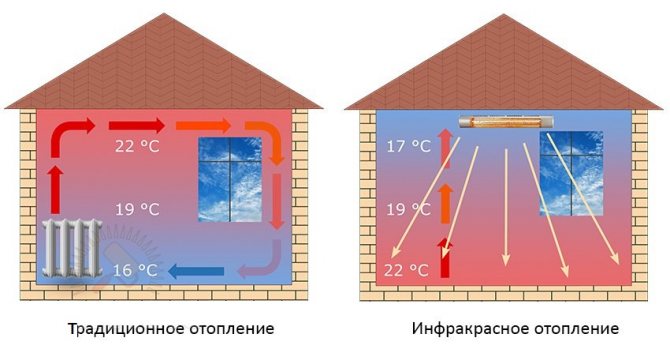

Manufacturers strive to maximize the performance of infrared panels. For ergonomics, safety, overload prevention, the emitters are equipped with additional options.
Much attention is paid to design. Today you can buy infrared step panels that harmoniously complement the concept of any design from classic to high-tech.
When choosing infrared panels, the price is not the main indicator, it is important to understand for what purposes the equipment will be used. There is a wide range of models on the market: from household electrical to gas industrial.
Electric emitters are easy to operate, have an impressive resource with a fairly compact size.
Types of IR panels are classified according to the type of heating element:
- Ceramic - they are a thin hinged panel with an external thermostat, a resist cable acts as a radiator;
- Carbon - economical models that provide a therapeutic and therapeutic effect, a quartz tube with carbon nano-fiber acts as a heater;
- Film - a budgetary, popular option, installed in any convenient place, a flexible resist cable acts as an emitter;
- Gas - gas is used as an energy resource, they work on the principle of electrical appliances, have a high thermal power, and impressive dimensions, are intended for industrial purposes, there are also more compact devices that are installed on open verandas in the cold season.
The key indicator when choosing infrared heating panels is the power, which depends on the wavelength:
- Longwave - mainly for home use.
- Medium-wave - can be used at home, in the country, as well as in industrial premises.
- Shortwave - used mainly in industries.
Today the infrared panel is wall-mounted:
- It is considered a high-tech device of the latest generation.
- Most of the top models are equipped with a reliable security system and advanced automation.


